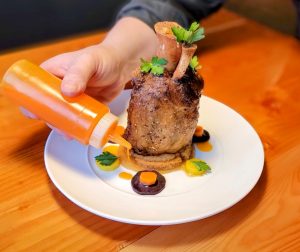 The cold weather brings upon us the season for braising. The opportunity to not only put something hearty and comforting on the table, but to perfume the house with the savory aroma of the best the season has to offer.
The cold weather brings upon us the season for braising. The opportunity to not only put something hearty and comforting on the table, but to perfume the house with the savory aroma of the best the season has to offer.
Using good ingredients as a foundation, we can bring the very best out of some of the less utilized cuts on the market with very impressive results.
In this instance, I have used a pork shank. My favorite pork at the moment is coming from Marks Family Purebreds. The marbling and freshness of the products is second to none. This dish can also be done with beef, or certainly some of the great Lamb from Yellow Table Farm if it is available.
For this dish you will need:
- Fresh pork shank, seasoned aggressively and patted dry
- Lard or canola oil for browning
- 2 large onions, French cut
- 6 large carrots sliced to 1/4 inch thickness
- 8 peppercorns
- 3 bay leaves
- 2 quarts of pork stock or chicken stock
- 1/4 cup of good red wine. I suggest Cru9 Pinot noir with pork, or Cabernet with beef
Directions:
- We will need to start with one shank per person, generously seasoned with salt and pepper. I like a large heavy bottom pan that can be used for browning in addition to braising.
- Over medium high heat, sear the shanks on all sides till golden brown. 5 to 7 minutes. This will flavor the entire dish and add an element of maillard to our final broth.
- Remove shanks from the pan and place on a plate and be sure to reserve any juices lost while resting.
- Be sure not to burn the fond on the pan before introducing the French cut onions for caramelization. After roughly 5 minutes, the onions should be nice and dark, and perfume the room with their sweetness.
- Introduce the peppercorns to the hot pan. Once you can smell them, probably less than a minute, introduce the bay leaves.
- Once the leaves begin to brown, deglaze with the wine and add the shanks.
- Cover the shanks with stock.
- I typically wrap with foil and place in an oven at 275 for 5 to 6 hours, but they could also be finished on the stovetop with a foil wrap or parchment cartouche to eliminate evaporation. The tenderness of the shanks will tell you when they are done.
- Once tender, make sure the shanks come down in temperature in the braising liquid to reabsorb collagen. I usually pull a couple cups of the liquid from the pan and reduce to 1/3rd volume to create the final sauce.
- These shanks would be fantastic with mashed or roasted potatoes. In this case, I served them over crispy polenta with rainbow carrots glazed in the braising liquid.
Thank you for cooking with us!
Clint Goodman
Goodman Hospitality
